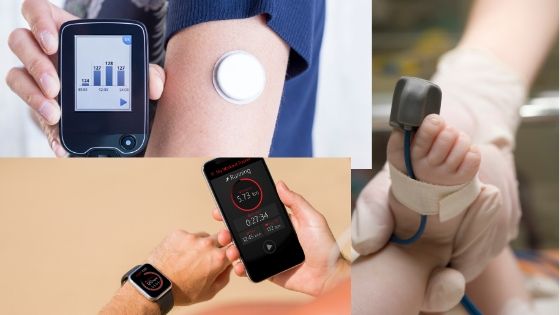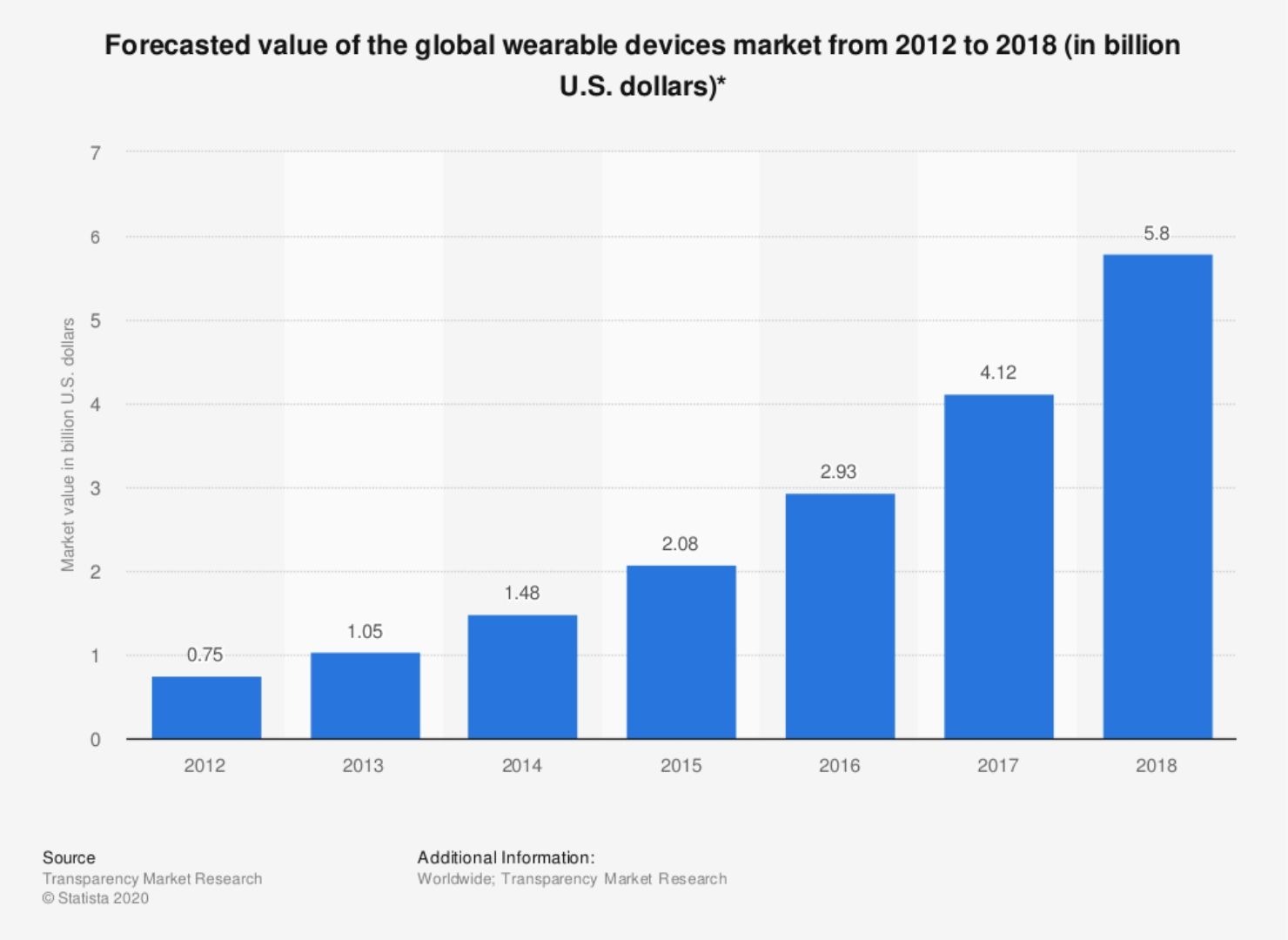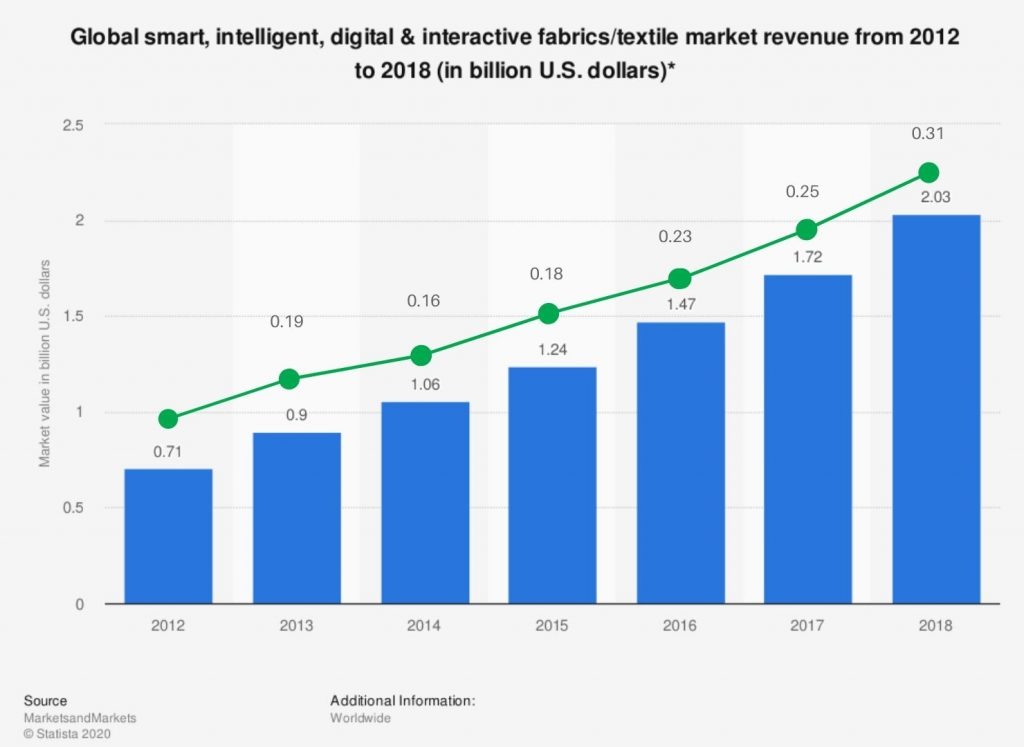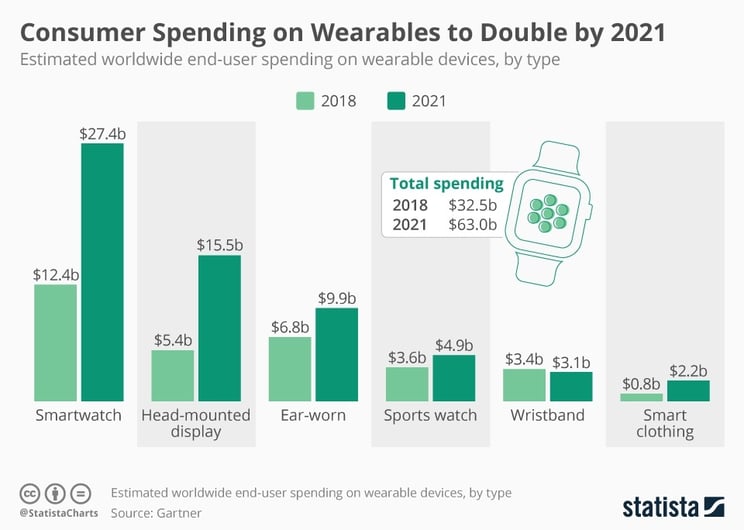1. What are Wearables?
Wearables can be described in many ways. The simplest definition is “technology that a person can wear”. According to Webopedia, wearables are defined as “a category of technology devices that can be worn by a consumer and often include tracking information related to health and fitness”. Sometimes wearables can be referred to as smart garments, smart clothing, electronic textiles, and smart fabrics.
Technology can be designed in many different industries. Which is one of the main reasons why wearables is such a broad topic. There are multiple industries that wearables can be implemented into such as performance sportswear, medical, military and defense, and the safety industry.
There are almost endless amounts of examples of wearable technology. The wearables industry is usually in reference to a sensor being implemented into clothing. The sensor can be integrated into a smartwatch, helmet, or clothing. It could also include other technology, such as flexible heaters that are applied to jackets. Printed heaters that are combined into a jacket are perfect for winter commuters and athletes.

Another type of technology that is popular within the smart clothing world is using lighting elements. An example would be LED’s that can be added as a safety feature for running at night.
Sensors are printed on thin and flexible films using conductive inks. Once a sensor is created there are many applications that the sensor can be integrated into. Since the sensor is flexible it is easily added to articles of clothing. The wearables industry has come a long way. One of the best things about the sensors is that they are wireless, meaning the user doesn’t have to be stuck in one spot tied to a machine.
Check out another one of our blogs about E-Textiles to learn more!
2. Why are Wearables important?
Wearables are needed in two main industries; medical and fitness. Medical professionals rely on sensors to monitor their patients. These new innovative sensors allow patients to wear a sleeve to track vitals, eliminating the need for getting tangled in bulky wires. Many people say that wearables are transforming the ways of medical researching.
 Another large benefit of the use of wearables in the health care industry is the fact that a patient’s vitals can be monitored remotely to measure progress after treatment. The sensors in a smartwatch will be able to send vital information to their personal smartphones as well as to their doctors. A recent discovery in the wearables industry is that they can be used to minimize wound recovery time. Printed heaters and electrical stimulation can be implemented into bandages for easy use at home, and the use of these two elements helps wounds to have a speedy recovery time.
Another large benefit of the use of wearables in the health care industry is the fact that a patient’s vitals can be monitored remotely to measure progress after treatment. The sensors in a smartwatch will be able to send vital information to their personal smartphones as well as to their doctors. A recent discovery in the wearables industry is that they can be used to minimize wound recovery time. Printed heaters and electrical stimulation can be implemented into bandages for easy use at home, and the use of these two elements helps wounds to have a speedy recovery time.
Athletes are also a big fan of wearables. When training, athletes will be able to track their muscle activity. Tracking an athlete’s vitals are also important. By analyzing respiratory and heart rates, the app tracking their data can send them an alarm informing them that they’re overworking themselves or if they need to take a break. Since all their vitals are being tracked during their workout, it is easy to measure the professional’s progress for a long period of time.
3. What are the market trends and forecasting for Wearables?
Worldwide almost every product line within the wearables industry is predicted to grow, and in a few cases, even double the spending from 2018. Statista breaks the wearable industry into 6 main categories. They predict that the smartwatch industry will more than double within the next two years. Even the smart clothing industry is set to grow to over 2.2 billion by 2021.
Statista also breaks down the wearable fitness market. Worldwide it is predicted that there will be 367.2 million users by 2023. Their findings also stated that wearables are most popular between the 25-34-year-old age group. In 2019 they found that wearables are more popular with females. They also studied wearable users by their income, showing that wearables are popular regardless of the income range they fall into.
Historical Data
Historical can be a broad term to use in this case. The smart market has only been around really since the turn of the century. Even today many people do not know what printed electronics are. Through the tremendous speed at which technology is evolving, there are new applications and uses coming to light every day.
Statista has been collecting data on the smart wearables technology industry for a few years. According to their records, in 2012 the wearable device market was only pulling in about three-quarters of a billion dollars. By 2018 the wearables market more than quadrupled within the six-year time span. This wearable device market also includes smart watches.

To be more specific let’s look at the smart fabrics and clothing industry. When analyzing these numbers, remember to keep in mind that this market is only one part of the previous, wearable device, market that was discussed. It is easy to tell that for the first four years of this graph the trendline has grown about 17 million year over year. On the other side, in the last three years of the graph, the trendline has grown over 26 million year over year. This is nearly a 65% increase when comparing these two sections of the graph. I predict this trending to grow more rapidly throughout the next few years. One major reason why I see rapid growth in this industry is that the larger industry is also predicted to grow. Another reason is that technology like smart clothing is becoming easier to manufacture and overall cheaper for the end consumer.

Still have questions?
Wearables is a broad term that can be described in many different ways. There are a lot of different wearable applications to make the consumer’s life easier and safer. It’s a known fact that the technology industry grows at a rapid pace. There is also lots of research to prove that the wearable market will continue to grow in the future.
Continue your learning journey by going to our E-Textiles page has more information related to Electronic wearable technology.
Meet the Author

Ashley Foster is a graduate of Slippery Rock University, where she earned her Bachelor’s degree in Business Administration, majored in Business Management and minored in Marketing. While Ashley was studying at SRU she found a passion for marketing. Although she is busy working, she spends her free time traveling and hiking with friends. She is also a volunteer for the American Marketing Association, Pittsburgh Chapter, and an active alumni member of FCCLA.
